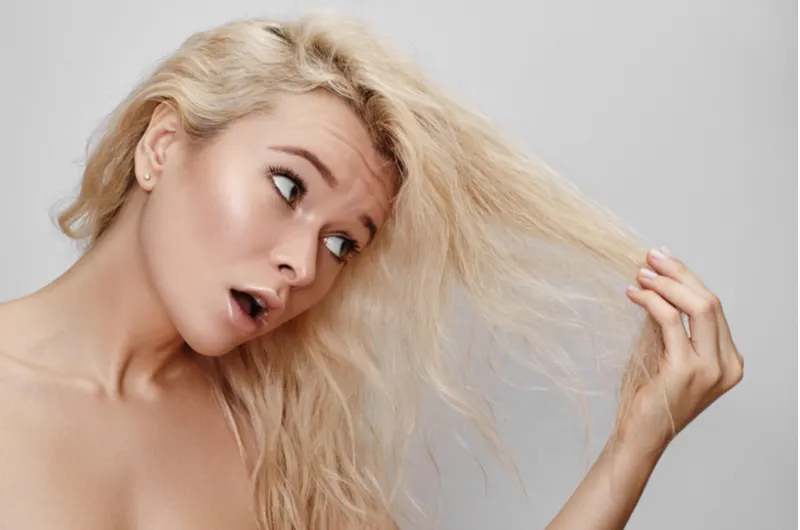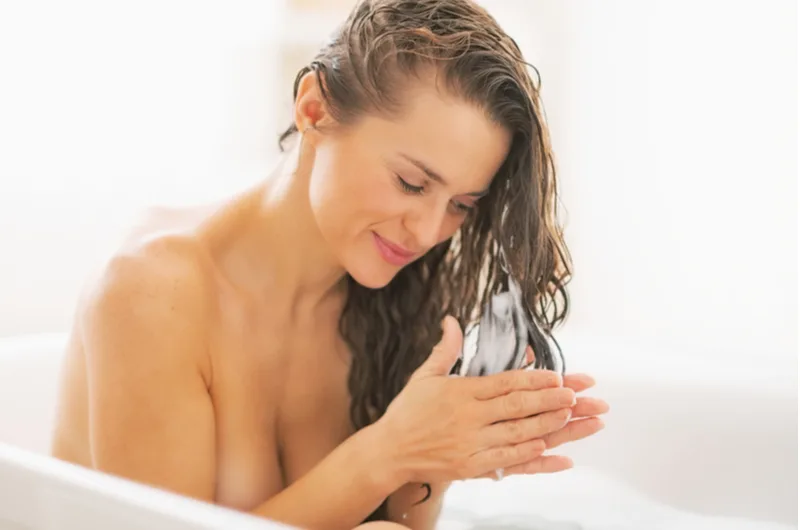Jump to:
It can be fun to experiment with bleach; however, attempting the bleaching process at home is not recommended. For those who dare to try, you may wonder — does bleaching your hair damage it forever?
Does Bleaching Your Hair Damage It Forever?
The quick answer — yes, and no. Yes, as you can damage your hair beyond repair if bleaching isn’t done slowly and correctly. And no, because if you’re careful, you’ll likely end up with the results you want with little to no damage.
You Might Also Like:
- How Often Can You Bleach Your Hair?
- How Long to Leave Bleach in Hair
- Can You Dye Your Hair After Bleaching?
What Is Hair Bleaching?

Schankz/Shutterstock
Hair bleaching is a chemical process used to lift color and remove melanin to get a lighter pigment. Bleach does this by trapping heat and moisture from your scalp, called the oxidation process created by chemicals such as ammonia and peroxide.
In most cases, it takes months of bleach processing to go from dark to platinum, as the process requires playing with toner, repairing bleached hair, and taking precautionary measures to avoid your hair from falling out.
What Is Damaged Hair?
Damaged hair can look sad and disappointing. It may appear frizzy, dry, and brittle. Have you ever taken a shower and noticed that multiple hair strands have fallen out? This is the first sign of damaged hair. Try pulling on a strand of hair.
If it falls out easily, you likely have brittle hair. Damaged hair can be hard to reverse, but taking measures to restore it will prevent any future damage.
Signs You Should Not Bleach Your Hair
Over-processing or constant bleaching and heat products will permanently damage your hair if you don’t take time to relax. Factors such as tight pulling hair ties and overexposure to the sun are also damaging culprits.
You should not bleach your hair if you notice:
- Loss of shine due to non-existent oil production
- Tangled and knotted hair that isn’t fixable (no matter how much you brush)
- Dry and breaks easily
- Frizzy flyaways that aren’t fixed with products or water
- Split ends
Read Next: Should I Bleach My Hair?
How Does Bleach Cause Damage?

Marinafrost/Shutterstock
Bleach is invasive and always harmful to your hair to a certain extent. Here are the main ways bleach causes damage:
- Swelling of hair strands – Alkaline agents cause the hair to swell, opening the cuticles and allowing for rougher, fuller hair.
- Melanin dissolution – Melanin produces the natural hair color you were born with. Bleach rids this color, making your hair neutral, which is damaging.
- Changes in the look and feel of your hair – Your hair may become frizzy dry with split-ends. Bleaching does this because it decreases elasticity and causes porosity.
The damaging nature of bleach is most commonly exacerbated by impatience, as too frequent bleaching and overexposure cause more harm and may lead to severe issues, such as hair loss and, in rare cases, even skin burns.
What Causes Permanent Hair Damage?
Causes of hair damage range from brushing your hair incorrectly (or not at all) to overuse of hair products and styling tools. When you don’t give your hair a break, the chances of having permanent hair devastation increase. Some causes include:
- Using the wrong type of shampoo and conditioner for your hair – one size does not fit all.
- You wrap your hair in a cotton towel rather than a microfiber towel after each shower
- Don’t condition enough – or you’re using a low-quality conditioner
- You overuse heat products without heat protectant
- You always have your hair up in a tight ponytail so your hair can’t breathe.
How to Bleach Your Hair Without Damaging It
So, you want to know how to bleach your hair. First and foremost, you should never bleach your hair if it has just been washed. Aim for roughly three full days before you attempt the bleaching process.
For the best results (without going over the process), you’ll need those natural oils to protect your scalp and allow the bleach to bond to the hair follicles. Before bleaching your hair, you should always do a test strand first.
Mix a small amount of bleach with 10 or 20 developers and take a strand from the back underside of your head to bleach. Wait the desired time (no longer than 45 minutes) and rinse it out. The color of the strand test will be what you can expect for the rest of your head.
Other prevention methods include:
- Using a good quality bleach – ask a professional for help (make sure the bleach is not expired)
- Starting with a bleach wash – Mixing shampoo and bleach helps your hair get used to the bleaching process, which won’t damage it as bad.
During the bleaching process, it’s prudent to check on your hair every five to ten minutes. If you leave the bleach on for too long, you’ll likely permanently damage your hair to the point of it falling out.
And if you don’t leave it on long enough, you won’t achieve the desired results. Once your hair is bleached, stay away from chlorine pools and heating products.
Your hair will already be exhausted and fried due to the oxidation process. Make sure to follow the tips below that will help you get through the hair bleaching process with little to no damage.
1. Know Your Developer
The higher the volume, the more damaging it will be to your hair. A few things to keep in mind are:
- Volume 10 Developer – Only for depositing color – not for lightening
- Volume 20 Developer – Lifts hair by one to two levels – people with light brown to dirty blonde should use this.
- Volume 30 Developer – lifts two to three levels lighter – for people with dark brown hair
- Volume 40 Developer – the most extreme lift you can get and very damaging – for people with black hair, use sparingly and not for longer than 30 minutes.
Read Next: The 5 Main Types of Hair Developer
2. Toner Is a Must
The undertone of your hair will give your brassy or yellow results. This is where toner comes in if you’re striving for platinum blonde. Again, a toner isn’t one-size-fits-all. Depending on the level of your hair after the bleaching process will determine what kind of toner you’ll need.
3. There Is a Right and Wrong Way to Bleach Your Hair
Beginner experimenters often mistake lathering bleach on as they would dye, and they’ll start with their roots. Both newbie mistakes are the wrong way to bleach.
If you start with your roots, you’ll end up with lighter, more bleached hair than the rest; however, if you start at the very tip of your hair, you’ll damage it more than you intend to. You must aim by starting about half an inch away from your scalp and work your way down. Only the last fifteen minutes should you lather your roots and tips.
Keep checking your hair every five minutes. When your hair looks white or very pale, it’s time to rinse it out. If you leave bleach in for too long, you risk hair breakage, dryness, and fallout.
4. Care for Your Bleached Hair Immediately After the Desired Result
Immediately after you have bleached your hair, you’ll want to apply a high-end shampoo, like Olaplex, and conditioner for bleached hair. Once a week, you’ll need to delve into a hair mask alongside deep conditioning and oil treatments.
You’ll also want to get a trim to help your hair heal quicker. You don’t have to avoid styling treatments, but it’s good to remember that your hair is more susceptible to damage after a bleaching process.
Read Next: How to Use Olaplex
How to Repair Damaged Hair After Bleaching

Alliance Images/Shutterstock
Firstly, you’ll want to reach for deep conditioners and repair oils to get your hair back to a healthy recovery. Coconut, argan, and almond oil are some of the few oils that will help to restore your damaged hair.
Other tips for repairing bleach damaged hair include:
- Do some research on your hair type – and only use products for your specific hair.
- Give it a three-month break
- Only wash your hair in cool water
- Let hair air dry – do not wrap it in a towel
- Apply weekly deep conditioning hair masks
You don’t need to avoid hair styling altogether. However, if you want healthy and recovered hair, you’ll want to style your hair every other day.
Frequently Asked Questions
Here are some common questions that others have asked.
Does bleaching your hair make it thinner?
No, if anything, the bleaching process thickens your hair as the alkaline ingredients cause your hair to swell and open up.
However, if you constantly bleach your hair without giving it a break or taking necessary precautions to strengthen it to repair it, over time, you may damage your skin, which could impact hair production.
Does bleaching damage natural hair?
You will almost always get the desired results if you’re attempting to bleach on virgin hair, which isn’t that damaging. However, with the continued use of bleach and dye, your hair will become damaged quicker.
What are the long-term effects of bleaching hair?
There are no ‘long-term’ effects from bleaching. However, after you first bleach your hair, it becomes prone to damage, as you have weakened the natural flow and structure.
Problems from bleaching consist of hair growth slowing or stops, constant struggles with frizzy and dry hair, and never-ending split ends.
Does bleaching your hair permanently change the color?
In itself, bleach does not change color; it lifts the undertone and lightens the pigment in your hair. Over time, your roots will grow, and your natural undertones will become more dominant.
For example, if you have a red undertone and bleach your hair, it will be brassy. If you leave it alone, your hair will return to the undertone color as your new hair grows.
Does bleaching cause hair loss?
In short, no – bleaching shouldn’t cause hair loss. As we’ve discussed, it can absolutely cause damage to your hair, but the bleaching process doesn’t cause your hair to fall out. In the rare case that this does happen – it’s likely because of a chemical reaction gone wrong.
Can bleaching cause gray hair?
Sometimes. With every bleaching session your hair undergoes, it holds onto a little bit of hydrogen peroxide. Over time, this can lead to hairs turning gray prematurely. With that said, you would need to bleach your hair pretty consistently, and over a pretty long period of time to see this result.
Does bleaching your hair kill lice?
A fairly common, and well-intentioned, assumption is that chemicals like hydrogen peroxide can kill headlice. While this isn’t untrue, it’s not a method you should rush to try out.
Lice and nits have very strong bodies and shells, so you would need to use the bleach for a while before it kills them. And by the time it has, it’s likely done serious damage to your hair that just isn’t worth it.
So, Does Bleaching Your Hair Damage It Forever?
While bleaching does not damage your hair forever, you’ll become prone to further damage from other things such as heat stylers, the wrong hair products, and the environment around you.
Although there is not much you can do about your environment, you can take measures to repair your hair, such as finding the right hair products for your specific hair type and giving it a good, long break before attempting bleach again.
